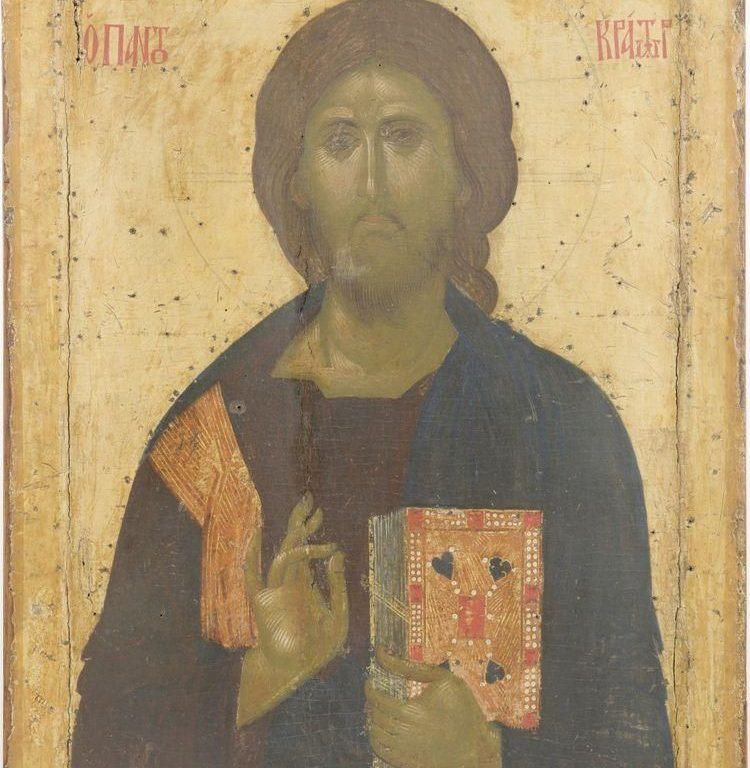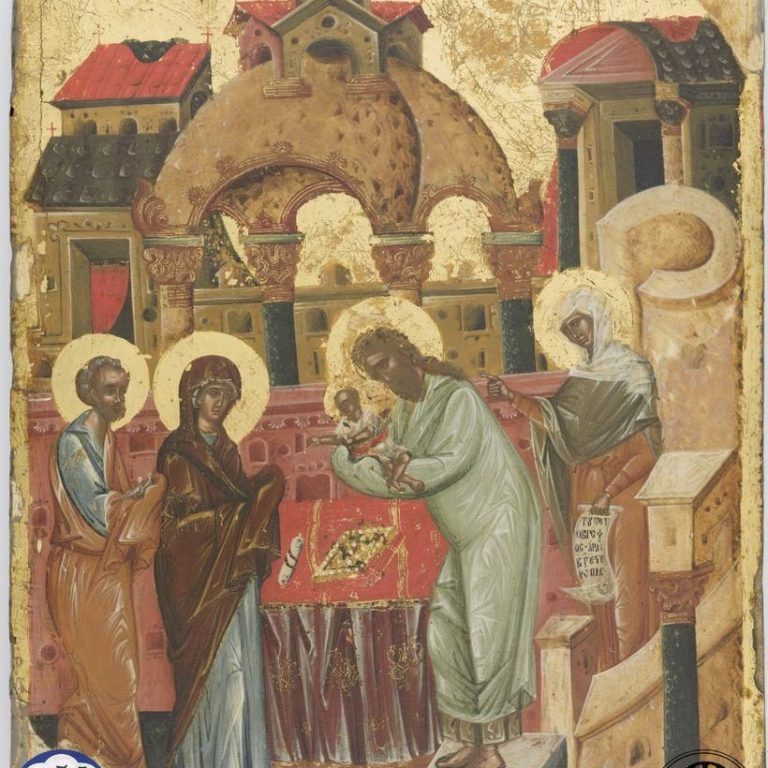Portable Icons
A very large number of portable icons from the Byzantine and post-Byzantine periods have been saved, and are safeguarded today in the Sacristy and the icon vault of the Monastery, forming as mentioned previously one of the most significant collections of portable icons from Agios Oros. Some of these icons, in fact, are considered to have been gifts of the founders, such as the icon of Christos Pancratoras (today in the Hermitage Museum of St Petersburg), which depicts the personages of the founders Alexios and Ioannis at the sides of Christ, and two large-sized icons by an unknown artist which date to the second half of the 14th century.
Ten icons are dated to the 14th century, the most important of which are: (a) an icon of Christos Pancratoras, which appears to be technically related to the above-mentioned icon of the founders, (b) an icon of St Athanasios the Athonite, which is the oldest portable icon of the founder of the cenobitic monastic community on Agios Oros, and (c) a bi-facial or double-sided icon, with depictions of St John the Baptist on one side, and the Virgin Mary holding the infant Christ with St John looking towards them on the other. An inscribed cross also dates to this period, with an image of Christ in its centre, the images of the Virgin Mary and St John on the horizontal panel, and the Preparation of the Throne on the upper edge of the vertical panel.
An analogous number of icons were works of the 15th century, and come from both Greek and Slavic workshops. Several icons have exceptional artistic significance: the icons referred to as Υπαπαντής (Ipapantis, 'The Visitation'), Λυπηρό (Lipiro, 'Man of Sorrows'), and one belonging to the group of three icons comprising the Great Deesis have particular artistic value.
Another group of exceptionally important portable icons comes from the Cretan School of the 16th century, which is characterized by a spirit of austere and at the same time peaceful ascetic images. Among these icons, two stand out: Christos Pantokratoros and the Virgin Mary of All Joys (in the cathedral of the Monastery, along with an icon of the Μεταμορφώσεως (Metamorfosis, 'the Transfiguration') which has been attributed to Theofanis Strelitza of Batha (“Strelitza toupiklin Batha”), and is considered to be a work reflecting his artistic maturity (ca 1535). A second icon of the Transfiguration, along with one of the Baptism, is also attributed to that artist, whose name – together with that of his son, Simeon (1545/6) -- is linked with the artistic projects conducted at the neighboring Stavronikita Monastery.
Another group of icons from the same period are related to the works of Theofanis, such as the icon of the Επιταφίου Θρήνου (Epitafiou Thrinou, 'Lamentation at the entombment of Christ'), which exhibits common technical characteristics with the analagous portray in the cathedral of the Stavronikita Monastery, and the icon Σταυρώσεως (Stavroseos, 'the Crucifiied One'). Also important are two double-sided icons with small-sized representations of many different personages, the works of Ambrosios Emporos of Chania, the painter of miniatures who was active about 1600, and an icon of St Georgios, with scenes from his martyrdom, which also came from a Cretan workshop. The anonymous creators of these icons clearly mimiced the artistic style of Theofanis of Crete, but yet at the same time are fundamentally different from them.
Of exceptional quality and merit is the wood-carved architrave of the 16th century, with 31 scenes from the Lives of the Twelve Apostles, the Passion cycle, the miracles of Christ, and the life of the Virgin Mary, which fit stylistically between the Cretan School and the so-called Theban School.
Ten icons are dated to the 14th century, the most important of which are: (a) an icon of Christos Pancratoras, which appears to be technically related to the above-mentioned icon of the founders, (b) an icon of St Athanasios the Athonite, which is the oldest portable icon of the founder of the cenobitic monastic community on Agios Oros, and (c) a bi-facial or double-sided icon, with depictions of St John the Baptist on one side, and the Virgin Mary holding the infant Christ with St John looking towards them on the other. An inscribed cross also dates to this period, with an image of Christ in its centre, the images of the Virgin Mary and St John on the horizontal panel, and the Preparation of the Throne on the upper edge of the vertical panel.
An analogous number of icons were works of the 15th century, and come from both Greek and Slavic workshops. Several icons have exceptional artistic significance: the icons referred to as Υπαπαντής (Ipapantis, 'The Visitation'), Λυπηρό (Lipiro, 'Man of Sorrows'), and one belonging to the group of three icons comprising the Great Deesis have particular artistic value.
Another group of exceptionally important portable icons comes from the Cretan School of the 16th century, which is characterized by a spirit of austere and at the same time peaceful ascetic images. Among these icons, two stand out: Christos Pantokratoros and the Virgin Mary of All Joys (in the cathedral of the Monastery, along with an icon of the Μεταμορφώσεως (Metamorfosis, 'the Transfiguration') which has been attributed to Theofanis Strelitza of Batha (“Strelitza toupiklin Batha”), and is considered to be a work reflecting his artistic maturity (ca 1535). A second icon of the Transfiguration, along with one of the Baptism, is also attributed to that artist, whose name – together with that of his son, Simeon (1545/6) -- is linked with the artistic projects conducted at the neighboring Stavronikita Monastery.
Another group of icons from the same period are related to the works of Theofanis, such as the icon of the Επιταφίου Θρήνου (Epitafiou Thrinou, 'Lamentation at the entombment of Christ'), which exhibits common technical characteristics with the analagous portray in the cathedral of the Stavronikita Monastery, and the icon Σταυρώσεως (Stavroseos, 'the Crucifiied One'). Also important are two double-sided icons with small-sized representations of many different personages, the works of Ambrosios Emporos of Chania, the painter of miniatures who was active about 1600, and an icon of St Georgios, with scenes from his martyrdom, which also came from a Cretan workshop. The anonymous creators of these icons clearly mimiced the artistic style of Theofanis of Crete, but yet at the same time are fundamentally different from them.
Of exceptional quality and merit is the wood-carved architrave of the 16th century, with 31 scenes from the Lives of the Twelve Apostles, the Passion cycle, the miracles of Christ, and the life of the Virgin Mary, which fit stylistically between the Cretan School and the so-called Theban School.



